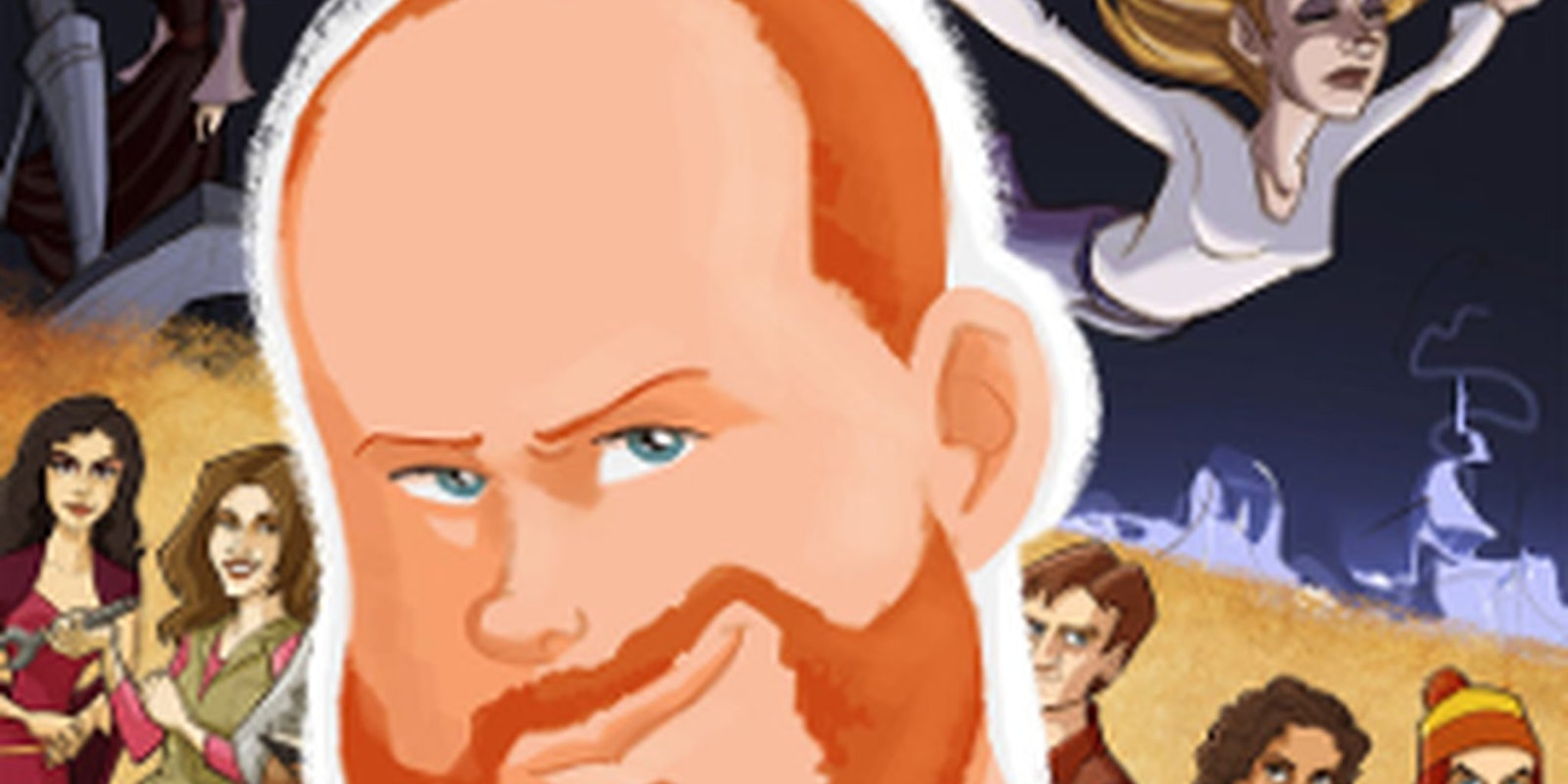It might have been inevitable that a film bringing together four separate film branches of one expansive Marvel Universe would be a blockbuster; but many star-struck fans are content to lay all the glory of 2012’s The Avengers at the feet of one man
It’s probable that in the last year you’ve heard a lot about Joss Whedon, the director who brought his own built-in cult fanbase to an even larger fanbase and united the two to produce the third-most profitable movie of all time. (Marvel recently confirmed he’d be helming the sequel as well.)
But what, apart from directing Avengers, has Whedon—just “Joss” to his massive fanbase—done to deserve such a widespread following? Is he still surfing a ten-year-old wave of love for a show about a girl who kills vampires? Hasn’t he only had a string of flops since? Is this just a geek thing?
No, no, and no.
While Whedon’s best-known project pre-Avengers is still Buffy, the Vampire Slayer, the reason for the reverence and devotions fans have for him is an amalgam of groundbreaking moves he made as both a writer and a director. Years of ongoing participation of geek culture, through both successes and heartbreaks, earned him the devotion of nerds who feel that he is one of them.
But his work has also garnered praise from a wide range of odd communities: from feminists—though more recently that praise has turned to criticism—to gay and lesbian viewers, from sci-fi fans to martial arts fans, and even the musical theatre community. Whedon seems to be that rare director/writer/creative visionary who really can do it all.
And if his fans have their way, the post-Avengers world is his for the taking.
Below, we walk you through the Whedon basics, with 17 reasons people hero-worship Joss—and the 3 big reasons not everyone is on board the love train.
Reasons people love Joss Whedon
He gave us the living embodiment of the female superhero
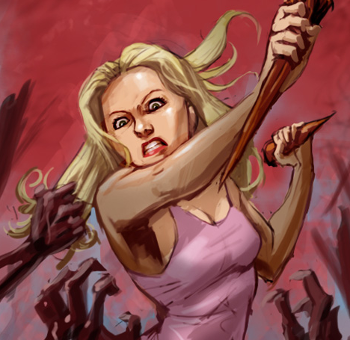
Illustration by pungang/deviantArt
In endless discussions of the “strong female character,” Buffy the Vampire Slayer is inevitably the lynchpin around which all other discussions of female characters and their relative strengths occur, because Sarah Michelle Gellar’s 64 inches of ferocious energy routinely gave the lie to the recurring myth that women just couldn’t hold their own in an action franchise. Without Buffy, we wouldn’t have had Alias, Nikita, or a female Starbuck in the revamped Battlestar Galactica.
Buffy, while she definitely had superpowers, was also a real girl who dealt with the real problems of growing up, family, relationships, and adult responsibilities. In the show’s best and rawest episode, Season 5’s “The Body,” we see a heroine who deals with death on a daily basis struggling to accept the death of her mother from natural causes. Whedon wrote and directed the episode, which was arguably the pinnacle of the series’ ongoing mastery at blending genre storytelling with real-life issues and relatable characters.
He taught a whole generation how to speak
Buffy and her team of wisecracking friends, dubbed “the Scoobies,” epitomized the language of late 90’s television. Buffy created its own specific language of teen-speak, called, of course, Buffy-speak, in which language itself gets manipulated to indicate smart but whimsical characters with inarticulate modes of expression, and self-aware pop culture references abound. Typical usage includes:
- Using “thing” and/or “thingy” to express all manner of things, large and small
- Turning words into made-up forms, using nouns as adjectives and vice versa
- Adding made-up suffixes like “-y” and “-age” to words that don’t actually have them
- Asking “[Adjective] much?” instead of saying “Stop being so [adjective].”
- Referencing a typical well-known plot trope or plot trope to explain that that plot trope has taken or is about to take place.
A self-aware character using Buffy-speak to describe a gunfight might say, “First there was this whole Menacing Bad Guy thing, and then everything went all High Noon-y with the bullets and the fight-to-the-deathage. We had to Mo Farah it out of there. Dramatic much?”
While this brand of speech made its way into everything from “Sorkinisms” to “Gilmore-isms“, it mostly died out in the early 2000s as a characteristic of prime time dialogue. But it continues to linger in modern language today, especially within Internet culture. The basics of Buffy-speak are still so ubiquitous today that you may not even realize their origins.
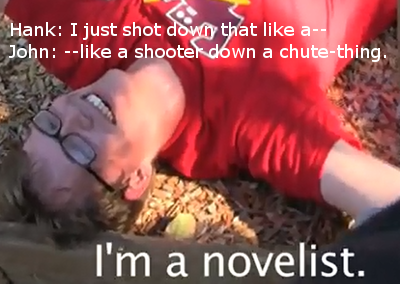
In 2010, 13 years after Buffy, Printz-award winning Young Adult author John Green engages in a little Buffy-speak.
In Willow/Tara, Joss gave viewers one of the first long-term gay relationships on television that wasn’t shamed, played up for ratings boosts, or passed off as “curiosity.”
The slow-burning but deep love that bloomed between Willow and Tara through the middle three seasons of Buffy was a milestone for queer visibility in Hollywood. Notably, their first kiss to be shown in the series took place in “The Body,” in which the kiss was utterly de-emphasized except as a way of expressing grief and comfort.
The initial outcome of the Willow/Tara relationship was highly controversial, with Tara’s death serving as the catalyst for the Season 6 finale and opening the relationship up to the accusation of the infamous and awful “dead lesbian” plot trope. But the relationship was a role model and an inspiration for countless queer teens looking for examples of representation onscreen, not to mention that even rarer instance: true love. Willow went on to have a last-season relationship with another girl, Kennedy, thereby quelling fears that her sexuality would be sent back into the closet.
He was one of the first writer/directors in Hollywood to fully embrace and court genre culture as the key to creating enduring fan bases—and boy, did it work!
Hollywood is still working to understand and fully embrace geek, sci-fi, comics, and genre culture, but at long last, in the era of Twilight, Game of Thrones, and the success of Marvel, it seems to have openly embraced Whedon as one of its own after years of downplaying his accomplishments. Fans have been idolizing Joss for just as long, putting him in a circle of elite male writers and creators like Neil Gaiman, John Green, and Wil Wheaton, who all seemed to emerge from geek culture into the mainstream, all while remaining interactive and close to their communities.
He effectively revitalized the horror genre, not once, but twice
Buffy used horror as an extended metaphor for growing up, a feat unmatched since Carrie, and one which influenced later acclaimed horror films like Ginger Snaps and Let the Right One In. Throughout his career Joss has sought to do interesting things with horror, such as creating an entirely new monster in “Hush” and fusing about 18 different sub-branches of the genre together in a new and self-aware way in last year’s feature Cabin in the Woods. Did we mention he co-wrote the screenplay in just 3 days?
He created witty and intelligent shows which rewarded audience engagement
Whedon treated his audience as sharp, savvy viewers, providing them with recurring motifs and plot arcs that sometimes took years to play out fully, thereby influencing an entire generation of television from Teen Wolf to Community.
He displayed one of the first intense levels of fan/creator interactions
On the early Buffy forums Joss not only participated and interacted with fans, but would frequently drop fan references into the show itself.
He was the first writer to effectively play mix-and-match with genre conventions, paving the way for a decade of self-aware television
In any given episode of Buffy, viewers could expect a mix of real comedy, real drama, action-adventure, and fantasy. Once they even got a musical. “From episode to episode, Buffy glided in and out of genres with ease, paving the way for shows like LOST and Battlestar Galactica to do the same later,” Sparknotes commented last year. Then came Firefly, a show that paid homage to everything from the anime Cowboy Bebop to Lord of the Rings to generic cowboy Westerns, all seamlessly blended into a work of blatant science fiction. And after that, he gave us the world’s first-ever superhero musical, told from the point of view of the villain. ‘Nuff said.
He launched both David Boreanaz and Nathan Fillion to fame
That’s right. Joss made two of your favorite procedural cop/author romances possible by supplying half of both Booth/Brennan in Bones and Castle/Beckett in Castle.
He gave us delicious nightmares in “Hush…”
The only episode of Buffy to receive an Emmy nomination for Best Writing, “Hush” simultaneously gave us nightmares and brilliant television. In “Hush,” a trio of debonair monsters known as “the Gentlemen” who preceded the Slenderman mythos. First, they steal your voice; then, your heart.
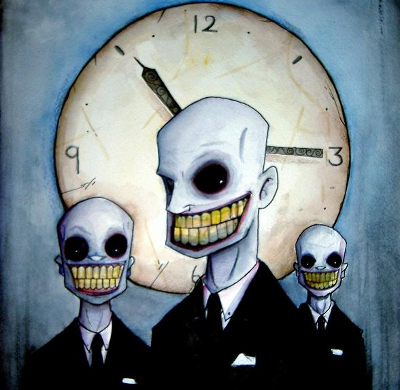
Illustration by uminga/deviantArt
Widely considered to be one of the scariest tv episodes of all time, “Hush’s” second act is entirely silent except for the film score, and contains a bit of classic Whedon: a creepy children’s nursery rhyme that warns you that you “Can’t even shout, can’t even cry / the Gentlemen are coming by… Can’t call to mom / can’t say a word / you’re gonna die screaming, but you won’t be heard.” That’s what we call nightmare fuel.
He was a huge Avengers fanboy decades before he directed The Avengers
Buffy is rife with references to the Marvel ‘verse. “The Avengers gotta get with the Assembly,” wrote Joss in one Buffy ep. For Buffy fans, the anointment of Joss as Avengers director was probably as sweet as it was for Joss himself.
He’s a huge musical theatre nerd …
… who featured many noted Broadway performers in episodes of Buffy, including Anthony Stewart Head, Harry Groener, legend Joel Grey, and 3-time Tony winner Hinton Battle, who played the jazz demon in “Once More, With Feeling.”
He wrote an entire musical
Joss took an entire six months to write one episode of Buffy–the iconic, critically acclaimed musical, “Once More, With Feeling.” And oh, was it worth it. OMWF is a full musical scored by Whedon, choreographed by So You Think You can Dance judge Adam Shankman and sung by the regular Buffy cast. Whedon’s score uses classic musical theatre techniques like internal rhyme schemes, want songs, list songs, and the big pre-intermission ensemble number. Like any good musical should, every number significantly advances the episode plot, as well as the seasonal plot. Along the way, Joss makes ample musical and lyrical references to everyone from Sondheim (he’s a huge fan) to Cole Porter.
Though Whedon took a huge gamble in writing the episode, which was a true television first, it paid off, garnering an Emmy nomination for musical direction (although it was accidentally left off the ballot) and frequently being listed as one of the best episodes of television of all time.
…And then he did it again
Joss took the “hey, gang, let’s put on a show!” mentality so literally that during the writers’ strike, he got his friends together and created Dr. Horrible’s Singalong Blog, a musical webseries starring Neil Patrick Harris, Nathan Filion, and Felicia Day. Created entirely to support the strike and get back to the basics of storytelling, Dr. Horrible was released for free on the Internet, to universal acclaim. It went on to win a Hugo and a Creative Arts Emmy for best short-form production.
It’s worth noting that Dr. Horrible is a great example of Joss’s creative vision: he did it purely as a way to support the writers’ strike, out of love for both musicals and comics, and as a simple experiment and gift to fans.
He’s always been viewed as an underdog and Hollywood outsider
Despite the success and legions of fans who were created around his first show, fans saw him as a recurring underdog, primarily because of the cancellation of Firefly. There’s nothing like a real-life hero having their creative ventures thwarted to make you rally around them with even more devotion.
Firefly united fans in heartbreak
A stylish hybrid of the “space opera” genre, which typically uses ‘the unknown West’ as its metaphor for space exploration, and traditional actual Westerns, Firefly was largely unlike anything seen on Western television. Cited by Boston Globe critic Matthew Gilbert as “a wonderful, imaginative mess brimming with possibility,” Firefly was a bafflement, what the Examiner dubbed “slipstream” rather than mainstream art. No one apart from ecstatic sci-fi and Buffy fans knew what to do with it, least of all Fox. The network’s abrupt cancellation of Firefly 11 eps into its 14-ep order devastated its fans, known as “Browncoats” after the show’s independence fighters, played by Nathan Fillion and Gina Torres.
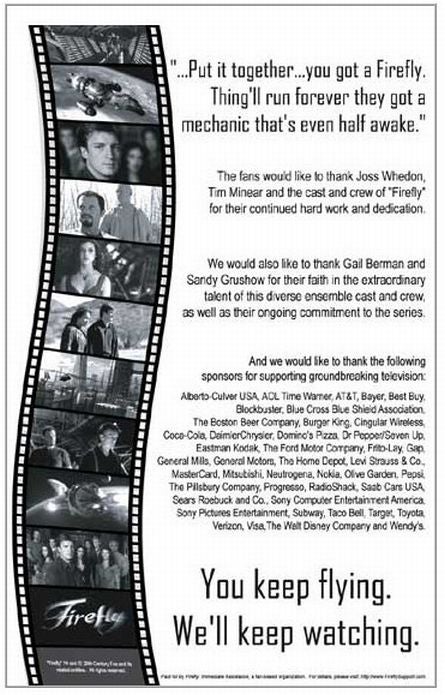
Variety ad from Firefly fans to support the show before cancellation, image via the_chulk/Flickr
Primarily due to devotion from fans and an ongoing word-of-mouth campaign, Firefly had a successful DVD release that led to the 2005 feature film Serenity. Though Serenity barely made back its budget, it was a message of love from Joss to fans, and it seems the good karma is still paying off.
While filming Avengers, he decided to put on a little Shakespeare
Over 12 days during the filming of the blockbuster action franchise, Joss got a bunch of friends together at his house and filmed a small-scale production of Much Ado About Nothing, just because they could.
No big deal or anything.
Reasons why people have problems with Joss Whedon
Even a beloved cult hero has his detractors, and Joss’s have only grown over time. Here are the three must-know reasons that will turn up in every discussion of all things Whedonesque:
Cultural appropriation/Racism
Firefly very overtly uses Asian influences in its sci-fi space opera Western setting, from showing characters wearing geisha outfits to integrating casual Chinese into the everyday language spoken by the main characters. For all of those influences, there are no Asian characters in the main cast, nor are there any Asian characters at all except as nearly-silent background extras. This problem has been critiqued on several fronts, most memorably in Lierdumoa’s acclaimed fanvid “How Much is That Geisha In the Window?“
Additionally, Zoe Walsh is frequently referred to as the token black female of the Serenity crew, which is still a step up from the all-white main casts of both Buffy and particularly Angel, where as one blog writes, “the only representation of POC [people of color] is the trope of ghetto-gang-hustler.” Dr. Horrible, Dollhouse, and Avengers all continued the WASPy trend.
Sexism
Despite the fact that Whedon has always been committed to writing main roles for women, and has a long track record of casting women in unconventional roles, his shows have had ongoing problems with sexism and gender relationships. His female characters’ strength is often depicted in purely literal terms, while instances of women being degraded and raped in his shows are disproportionately high. His most recent cancelled venture, Dollhouse, was widely criticized as misogynist for its frequent consent issues, sexualization of Eliza Dushku’s character, and scenes of abuse and violence against women. Cracked.com listed Firefly’s character River as an example of “Hollywood’s 5 Saddest Attempts at Feminism.”
The Mary Sue rounded up many of the issues with Whedon’s shows in “Reconsidering the Feminism of Joss Whedon,” although it conspicuously ignores major issues that crop up in Buffy seasons 6 and 7: notably, the gang rape and murder of a minor character, with two participant characters (Jonathan and Andrew) who were largely sympathetic; and especially the infamous attempted rape scene between Spike and Buffy, an act that ultimately brings the rapist and his victim closer together and leads to the rapist’s full redemption.
What largely gets overlooked in outrage about the attempted rape itself is that Spike stalked Buffy for two seasons, wore down her resistance to his overtures of affection, and at one point in Season 5, chained her to the wall and tried to force her to admit that she liked him. All of this is glossed over in Spike’s ongoing and successful redemption arc, which continues into Angel.
Meanwhile, many, many Buffy academics and critics have pointed out the ways in which sexual freedom in Buffy is often punished and the women who engage in it marginalized or otherwise demeaned, while some critics and fans have explicitly deemed Firefly a kind of rape narrative. Hathor Legacy has cautioned against viewing Whedon as an active feminist ally, rather than a director who just happens to give women interesting storylines but still fills those storylines with themes that hurt women.
He may be a better writer than director
While pretty much everyone, at least in a post-Dr. Horrible era, seems to agree that Whedon has talent as a writer, not everyone is as enthused about his directorial talents. In an essay about why Whedon shouldn’t direct Star Wars because one man shouldn’t have that much power over genre filmmaking in Hollywood (which later proved ridiculously ironic), Alyssa Rosenberg argues that Joss’s strengths lie elsewhere: “Whedon’s main accomplishment is revitalizing and critiquing the horror genre… He often seems relatively indifferent to actual action sequences. The fights in Buffy and Angel … are almost deliberately indifferent and schlocky in a way that robs tension from them.”
Meanwhile, legendary cinematographer Wally Pfister (The Dark Knight Rises, Inception) slammed Whedon’s direction in Avengers, describing it as “appalling” and citing the cinematography as inexplicable:
They’d shoot from some odd angle and I’d think, why is the camera there? Oh, I see, because they spent half a million on the set and they have to show it off. It took me completely out of the movie. I was driven bonkers by that illogical form of storytelling.
Despite getting a spate of early positive reviews, The Avengers was panned by the New York Times and other notable critics for wooden acting and a glut of special effects. “Whedon never finds a confident or relaxed narrative pace,” writes Salon’s Andrew O’Hehir, “and the results are exhausting, a picture that pushes three hours and feels like five.”
Do the positives outweigh the negatives when it comes to Whedon? That’s up for debate, but if you know the ins and outs of all things Joss, you’ll be on the fast-track for an invigorating discussion with your friends, no matter whether they love him, love to hate him, or are still in the first stages of asking: “Who?”
Joss Whedon’s next project, a contemporary adaptation of Shakespeare’s Much Ado About Nothing, premieres Saturday, March 9 at the SXSW Film Festival in Austin, Texas.
CORRECTIONS: A previous version of this article credited cinematographer Wally Pfister for Skyfall and No Country for Old Men. The director of photography on those films was actually Roger Deakins. Actor Anthony Heald was also credited with a role in Buffy—the actor who played Giles in the show is actually Anthony Stewart Head.
Illustration by aerettberg/deviantArt

